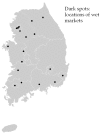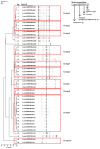Antibiotic Susceptibility, Genetic Diversity, and the Presence of Toxin Producing Genes in Campylobacter Isolates from Poultry
- PMID: 29149023
- PMCID: PMC5708039
- DOI: 10.3390/ijerph14111400
Antibiotic Susceptibility, Genetic Diversity, and the Presence of Toxin Producing Genes in Campylobacter Isolates from Poultry
Abstract
This study examined antibiotic susceptibility, genetic diversity, and characteristics of virulence genes in Campylobacter isolates from poultry. Chicken (n = 152) and duck (n = 154) samples were collected from 18 wet markets in Korea. Campylobacter spp. isolated from the carcasses were identified by PCR. The isolated colonies were analyzed for antibiotic susceptibility to chloramphenicol, amikacin, erythromycin, tetracycline, ciprofloxacin, nalidixic acid, and enrofloxacin. The isolates were also used to analyze genetic diversity using the DiversiLabTM system and were tested for the presence of cytolethal distending toxin (cdt) genes. Campylobacter spp. were isolated from 45 poultry samples out of 306 poultry samples (14.7%) and the average levels of Campylobacter contamination were 22.0 CFU/g and 366.1 CFU/g in chicken and duck samples, respectively. Moreover, more than 90% of the isolates showed resistance to nalidixic acid and ciprofloxacin. Genetic correlation analysis showed greater than 95% similarity between 84.4% of the isolates, and three cdt genes (cdtA, cdtB, and cdtC) were present in 71.1% of Campylobacter isolates. These results indicate that Campylobacter contamination should be decreased to prevent and treat Campylobacter foodborne illness.
Keywords: Campylobacter; Rep-PCR; antibiotic susceptibility; cdt toxin; poultry.
Conflict of interest statement
The authors declare no conflict of interest.
Figures
References
MeSH terms
Substances
LinkOut - more resources
Full Text Sources
Other Literature Sources
Miscellaneous



